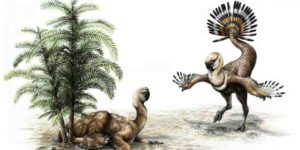
Attracting mates with showy displays may have helped dinosaurs develop feathers that let them take flight, according to new research by University of Alberta paleontologists.
“The first complex wing feathers show up in tiny raptor dinosaurs that could parachute and glide flying-squirrel-style through the prehistoric treetops,” said Scott Persons, who led the study while he was a post-doctoral researcher at the U of A.
“In this study, we explored how dinosaurs went from staying warm with simple hairy feathers to gliding on complicated wing feathers.”
The study makes the case that larger, stiffer, flatter feathers gradually evolved as showy fans on the arms and tails of dinosaurs to be waved and waggled in courtship displays, leading eventually to the evolution of birds—an interpretation supported by a growing fossil record of early feathers.
“Sexual display remains an important function of complex feathers in some birds to this day,” said Persons, who is now at the College of Charleston. “Think of the feather fans of turkeys and peacocks or the head crest of a cockatoo.”
A missing link
Persons said the feathers on a bird’s wing each have a central hollow shaft called a rachis whereas fossil feathers on many dinosaurs were covered only in simple hair-like feathers that nothing to do with flight. They served as insulation to keep dinosaurs warm.
“Going from simple hairy feathers to sophisticated flight feathers is a big jump. Evolution doesn’t normally work in big jumps. It’s gradual,” explained Persons. “Recognizing the intermediate function of sexual display explains a gradual way for simple feathers to have grown in complexity.”
Though the study offers clues about the evolutionary steps leading from dinosaurs to birds, there are still rich paleontological mysteries to explore concerning fossil feathers, Persons noted.
“We are still missing clear examples of sexually dimorphic feathers in dinosaurs. Today, it’s easy to tell the sexes of many birds apart based on their feathers,” he said. “Male birds tend to have larger, gaudier and brighter feathers because they are the ones doing the displaying.
“This was very likely true of feathered dinosaurs, but we haven’t found a definitive example … yet.”
The study, “Feather Evolution Exemplifies Sexually Selected Bridges Across the Adaptive Landscape,” was published in Evolution.
Reference:
W. Scott Persons et al. Feather evolution exemplifies sexually selected bridges across the adaptive landscape, Evolution (2019). DOI: 10.1111/evo.13795
Note: The above post is reprinted from materials provided by University of Alberta.










